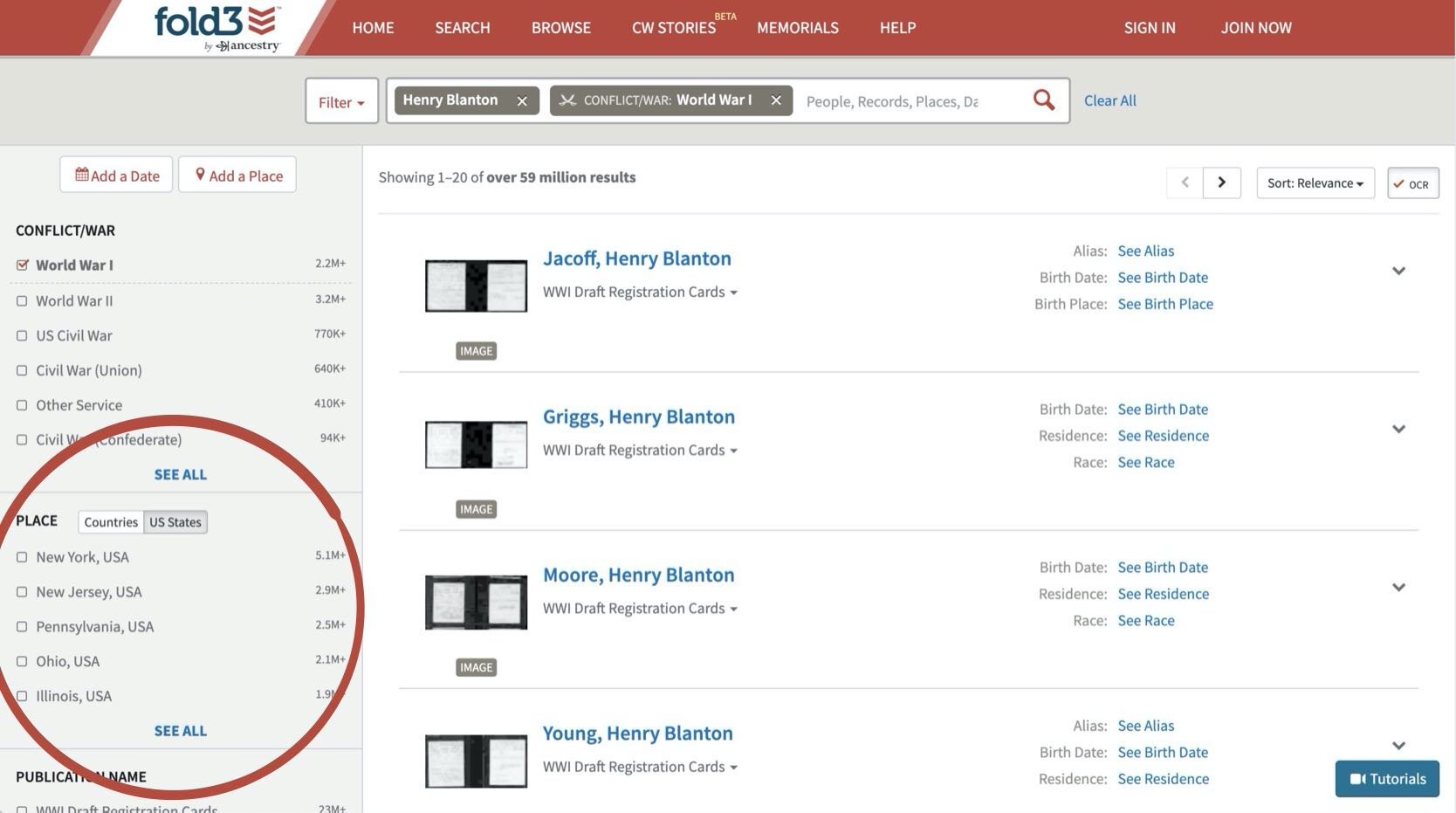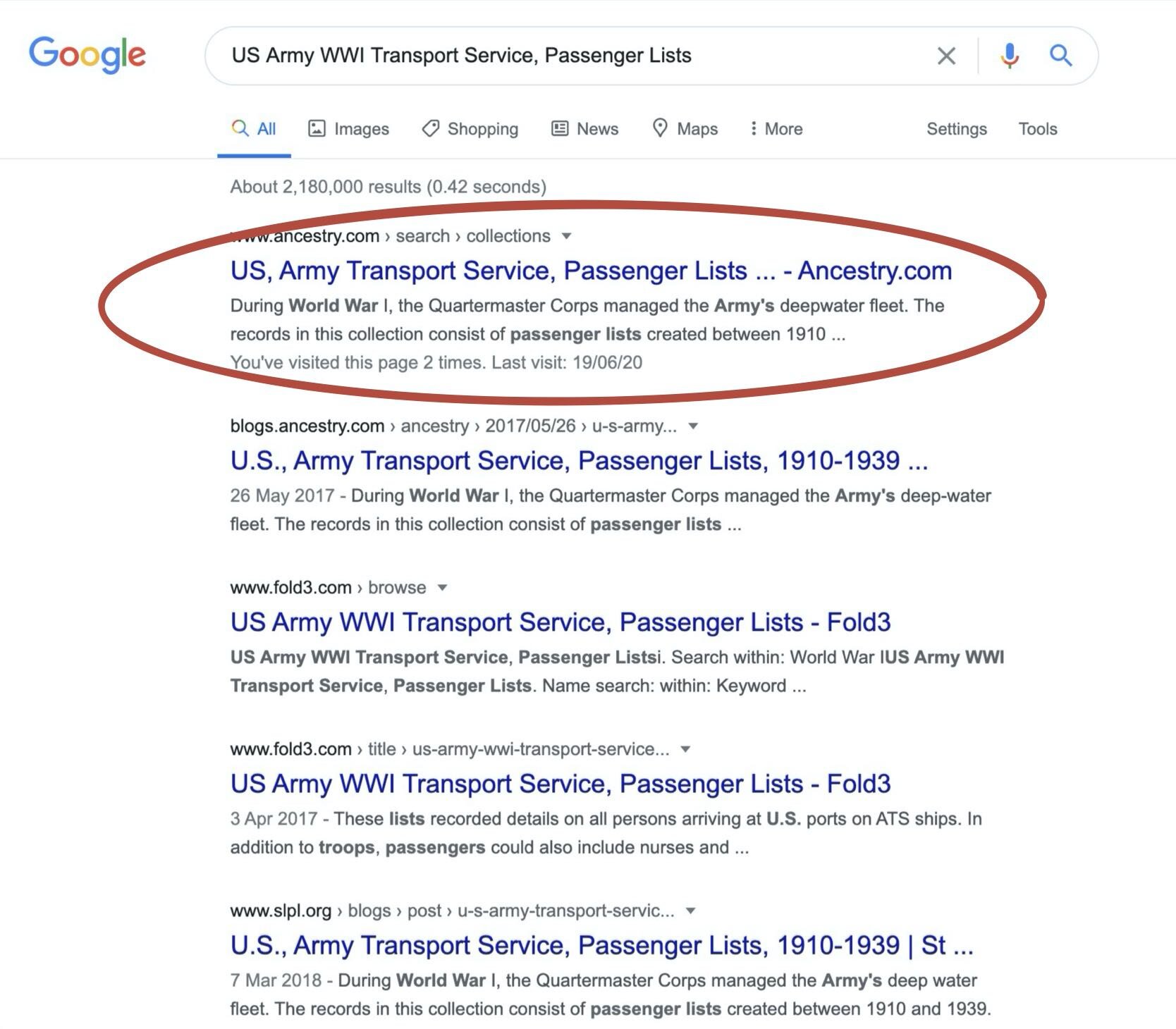Working around a paywall, an example with military records
If you’re familiar with Ancestry’s suite of products in the United States, you might be aware that most of their military records are locked away behind a website called fold3. We can get useful documents like draft registration cards in our Ancestry searches and hints. Still, some of the more specific military records are often indexed or shown exclusively on this additional paid site. Well, that is what I thought anyway, it turns out there are some records you can still get from Ancestry if you know to look for them there!
A bit of disclosure here, I do pay for my Ancestry membership, so if you don’t pay for Ancestry, you’ll struggle to see most images on their site. I don’t have a lot of fascinating military history in my family, that I’m aware of, so I never saw much use for a fold3 account, previously. This is also not a discouragement to pay for additional sites like fold3 where it would be helpful to you. I do pay the extra amount for Newspapers.com, another of Ancestry’s products because it is the most comprehensive access I have to newspapers in the US and I use it frequently. Though not being somebody that does do a lot of military searches, when I discovered this little workaround, specifically for World War I transport records from my great-grandfather, I was pretty excited.
My great-grandfather was drafted into World War I, and for the longest time, I had another record for him from a source of Ohio Soldiers in WWI. I never really dug into his military history until recently, so this source just sort of sat on my tree.
Entry for Henry Blanton from Ohio Soldiers in WWI, 1917-1918 (Provo, UT, USA: Ancestry.com Operations Inc, 2005).
I did do a little browse on fold3 for his name, I had never used the site before, but I do find their interface for browsing really good, and it’s nice to see that I can access this without paying for full access. I started by typing in his name, I selected World War I from the left side. Right away I can tell there’s little relevance to the Henry Blanton that I’m searching for. Also, draft registration cards are already available to me on Ancestry, but I was almost immediately drawn to the place options on the side of the screen.
Searching for entries on Henry Blanton for World War I, fold3.com
If I selected ‘See All’, I could see more of the options on the screen and drill down to them, which I found useful. I clicked on that and of course ‘Toledo, OH’ immediately stood out to me, and it only had three records here.
I clicked on that to see the three results, and bingo, this is the correct Henry Blanton. One was his draft registration card, which I already had, but I could see there were two army transport records available, which I didn’t have.
Searching for Henry Blanton in World War I by place, Toledo, Ohio, fold3.com
Just a note about this search technique, it’s not exactly foolproof, and I think I did get a bit lucky because Henry’s next of kin was his brother, George, who was living in Toledo on both of his journeys. However, when I looked into George’s records, his transport would have come up under Louisville, where his sister was listed as next of kin. But what digging around in a different database did get me was a bit more evidence that I hadn’t found by just using Ancestry searches alone.
At this point, I have evidence that more records might be available, but I’m stuck to view them unless I sign up and pay for fold3. But then I got thinking, so many of these databases now (and most of them I do pay for), have an overlap of records, maybe I’m able to view the images elsewhere instead. I did a little Google search for the image set, and behold, Ancestry already has them!
Searching for the US Army Transport Service Passenger Lists in Google verified that Ancestry also had these images.
I have to say they’re being a little cheeky here with some of their databases, only allowing some of them to be indexed with easy search tools, but the ones they want you to pay more to access they make you work to find on their own main website. But this is the business model I’ve grown accustomed to with Ancestry.
I went at the search knowing he probably had two records in this database, so bearing that in mind, I think this is also an excellent example of how to not stop at one technique, because my initial search actually only brought up one of those records. I thought the quickest way to locate it would be to use his service number, which I had on his Ohio Soldiers entry, so I got that number and then marked it down into the search box for service number (easy peasy).
Searching the US Army Transport Service, Passenger Lists by service number
Ancestry.com, U.S., Army Transport Service, Passenger Lists, 1910-1939.
Ok, one record came up, but why not two? Also, one of these is clearly my great-grandfather, one of these is clearly not.
Results from searching by service number brings up one correct record and one incorrect one, Ancestry.com, U.S., Army Transport Service, Passenger Lists, 1910-1939.
I decided next to go with a similar search strategy to my fold3 one to find the second record, which was his name and include the keyword ‘Toledo’. I could now see that this was coming up because his brother in Toledo was listed as next of kin.
Searching by name, Henry Blanton, and keyword, Toledo, Ancestry.com, U.S., Army Transport Service, Passenger Lists, 1910-1939.
I got the result I needed this time, and from here, I could easily see why his service number was not coming up on the previous search.
Locating his incoming transport record revealed that his service number was literally transcribed with commas, preventing it from showing in my previous search, Ancestry.com, U.S., Army Transport Service, Passenger Lists, 1910-1939.
The actual record on his return journey has the service numbers listed with commas separating the parts of it. The person who indexed this record did an exact transcription, so typing in this number on its own resulted in this one being excluded from my search with only the service number. It’s always good practice to document your searches so you can recreate them again at a later date.
I could have typed in his name and eventually found him in the list, with a less common name like his that does work fine, but keywords can help you narrow down if you know how to use them. Also, while my great-grandfather went by Henry, his full name was William Henry. If your ancestor has nicknames or name variations, a name search alone might bring up unexpected results.
The discovery of his transport records, especially his outgoing one, unlocked a few more findings of my great-grandfather’s travel to France. The most exciting was a discovery that the George Washington, the transport ship that took him to France, had its own daily newsletter. I was able to locate every issue of that newsletter from my great-grandfather’s journey and read the same words he was reading on board the ship over 100 years ago. Sometimes it is worth digging a little deeper!
My suggestion though is if you think there’s a source locked behind a paywall, try searching another site you might have access to, or doing a Google search on the title to see if it’s been scanned at an archive or library and available for free online. A lot of records are freely available on FamilySearch, for example, so even if your preference for family trees is Ancestry like mine is, you may find you can view the images of those same records using a free FamilySearch account. I wouldn’t go as far as posting those images back on Ancestry, I’m not aware of them actively discouraging people from posting them back to your trees, but I expect they could do to protect the access rights they give you to those same images. Also, I find that they clutter up my searches to see a lot of these popping up from other users in my search results. If you’re using them for your own research, you’re better off organising them locally so you can refer to them later.








